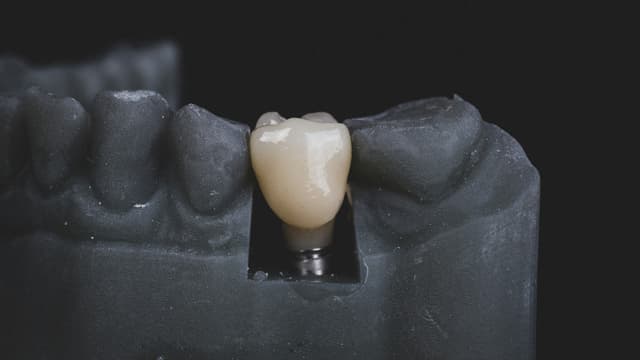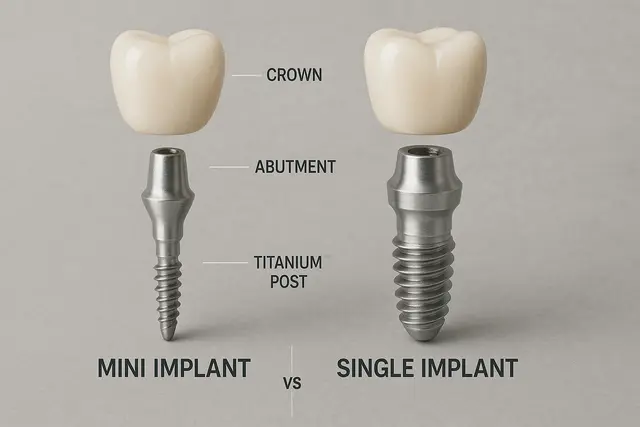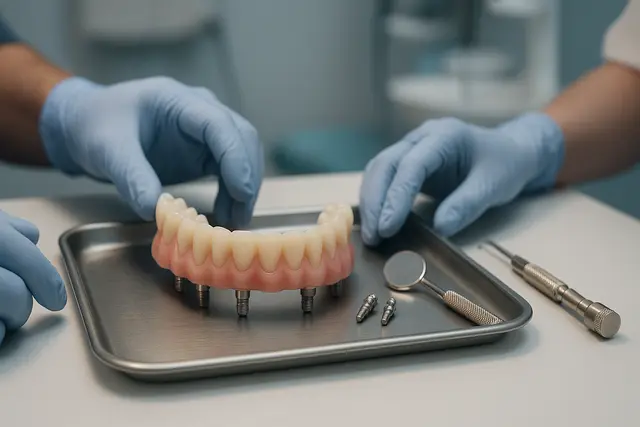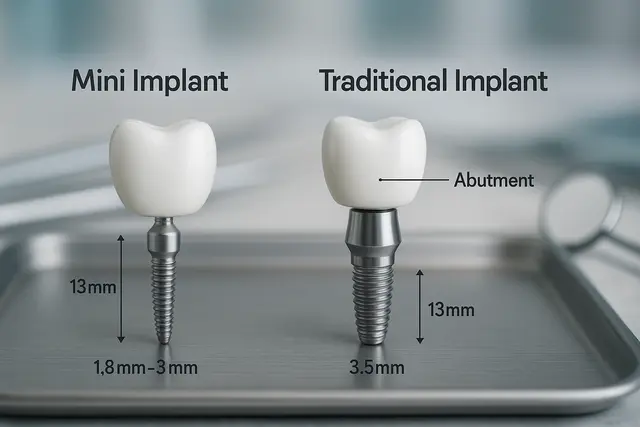Prosthodontics
6 min read
Mar 27, 2025
Dental Implants: Complete Guide to Types, Costs, and Long-Term Care
Losing even one tooth can feel like dropping a gear in life’s engine. You shy away from steak, mumble through selfies, and worry about your jawline sinking like an old tent. A modern dental implant steps in as a rock‑solid stand‑in for the original tooth root, letting you smile and chew with the same swagger you had before.

Dental Implant: The Modern Artificial Root
A dental implant is a small post, often made of titanium, surgically seated inside the bone of the jaw. Because implants are titanium, the natural bone treats the post like a friendly invader, allowing bone growth to lock it firmly in place. Think of it as laying a sturdy foundation before you build the visible crown.
The post, the implant abutment that connects to it, and the lifelike crown together create a tooth with a dental feel so real many people forget which tooth is “fake.” The implant system mimics your natural teeth from root to tip, so you avoid the slipping or clicking that removable dentures sometimes cause.
The Implant: Parts and Purpose
Every implant has three stars. First is the root‑like post. Second comes the abutment, attached to the implant once bone has grown around the implant and fused. Finally, the crown pops on top, shaped and shaded to match real teeth.
One implant may hold a single crown, while two or more implants used strategically can secure partial dentures or even a full arch. The result feels like a natural tooth because chewing forces travel down into bone the way nature intended, stimulating the jawbone and helping prevent bone loss. Implants allow you to bite into crisp apples and thick sandwiches without a flicker of fear.
Get Dental Implants: Are You a Candidate?
Choosing dental implants starts with a thorough dental exam, 3‑D X‑rays, and a chat about your health goals. Your dentist or oral and maxillofacial surgeon checks the bone in your jaw for height and width. If years have passed since implants also stopped bone stimulation, you might need a bone graft to grow enough new bone to support the post.
Smokers, people with uncontrolled diabetes, or anyone unwilling to practice stellar oral hygiene may face higher risks of implant failure, but implants are successful in most healthy adults. If you’re missing teeth and crave something that feels like a natural tooth, it’s worth asking about implant dentistry.
Dental Implant Surgery: What to Expect
The surgical procedure often takes about one hour per site. After numbing and optional sedation, the surgeon makes a small incision, gently exposes the bone, and drills a channel just wide enough to place the implant. A tiny cover screw seals the top, the gum is stitched closed, and you head home for a soft‑food evening. Antibiotics before surgery help prevent infection, and regular dental checkups afterward keep gums happy while bone grows around the post.
Dental Implant Placement: Healing and Osseointegration
Osseointegration, the stage of surgery where bone knits to the post, may take several months. During this time implants work quietly beneath the gum, encouraging enough new bone to support a dental crown for good. If you needed a bone graft first, healing can stretch a bit longer. Most patients report minimal pain, more boredom than anything, and get back to work the next day. Since implants can take time to stabilize, patience here pays lifelong dividends.
The Dental Implant Procedure: From Start to New Tooth
Once the bone is ready, your provider unscrews the cover, attaches the implant abutment, and takes a quick impression. A lab crafts a crown that blends with neighboring natural teeth, and at the final visit the crown is attached to the implant abutment. One or more surgical procedures may sound intense, yet most people say the worst part was waiting to eat crunchy snacks again. The stage is set for decades of confident chewing.
Types of Dental Implants and Implant Systems
The common type of implant is an endosteal post that sits inside bone, but several variations exist:
A single tooth implant replaces one missing tooth with ease.
Full mouth dental implants rely on four to eight posts per arch, supporting a bridge‑style prosthesis that never leaves your mouth.
Mini dental implants, sometimes called mini implants, use slender posts, great for narrow ridges or to snug up a loose lower denture.
Surgeons choose the type of implant and surface of the dental implant, smooth, roughened, or coated, based on your anatomy and biting forces. Reputable brands back each implant system with research proving long‑term success of the implant.
Implants Offer Advantages Over Bridge or Denture
First, implants attach directly to bone, so they don’t borrow strength from neighboring teeth the way a bridge does. Second, they stop bone loss by transmitting bite pressure into the jawbone. Third, implants allow you to chew steak, almonds, even corn on the cob without adhesive. Compared with a removable denture, implants improve the quality of life by letting you laugh loud, speak clearly, and forget all about that old glass of teeth on the nightstand.
Dental Implants Last: Longevity and Maintenance
With careful oral hygiene, implants are healthy for thirty years or more. Brush, floss around the implant daily, and schedule dental checkups twice a year. Avoid using teeth as bottle openers, and a dental implant may outlive you.
Studies from the American Academy of Implant Dentistry show implants are successful over 95 percent of the time when patients stick to home care and professional cleanings. Should problems arise, early attention prevents gum trouble from spreading and threatening the success of the implant.
A Quick Cost Snapshot
A single tooth replacement using an implant abutment and porcelain crown often runs four to six thousand dollars. Full mouth stacks higher, yet remember the leap in comfort compared to traditional dentures. Financing plans let many folks move forward without draining savings. Think of it as investing in confidence and steak dinners for life.
Caring for Implants Long Term
Treat implants like real teeth. Use a soft brush, glide floss beside the post, and consider an interdental pick to clean the surface of the implant where plaque sneaks in. Skip hard candy crunching, wear a night guard if you grind, and see your dentist twice yearly. Implants work best when the surrounding gum stays pink and firm, so keep sugary snacks in check and rinse after meals.
Potential Roadblocks and How to Dodge Them
Implants can take a little longer than a bridge, and implant may need extra healing if you needed graft work. Rarely, numbness lingers if the nerve sat close when surgeons expose the bone. Follow post‑op instructions and report any tingling that sticks around. If an implant system ever loosens, quick adjustments protect against bigger repairs.
Why Today’s Implants Are a Smart Bet
Since implants arrived on the scene decades ago, refinements in design, surface texture, and surgical protocols have raised success rates sky‑high. Implants allow chefs, teachers, and guitar players alike to live loud without dental worries. Whether you need least one tooth replaced or a full arch reboot, modern implant dentistry offers solutions that feel and function like a natural tooth.
Wrapping Up
A stable bite, a confident grin, and the freedom to order crunchy tacos again, dental implants deliver all three. From the initial dental exam to that first triumphant chew, each stage of care aims to restore more than just structure; it restores ease. If you’re ready to replace missing teeth and skip the slip‑slide of traditional dentures, talk to a trusted dentist about scheduling oral and maxillofacial surgery to place the implant.
The process takes commitment, but the payoff, real‑tooth strength and an easygoing smile, can last a lifetime.
How much does one implant cost?
Fees vary by region, graft needs, and crown material, but a single site often ranges from the mid‑thousands to the price of a used compact car.
Can implants fail?
Yes, though implant failure remains uncommon. Poor oral hygiene, uncontrolled diabetes, or heavy smoking can irritate gum tissues and invite infection around the implant.
What if I have one missing tooth at the back of your mouth?
One implant topped with a crown saves the neighbors from grinding for a bridge.
Are implants made of titanium safe?
Decades of data show implants are titanium and biocompatible; allergies are exceedingly rare.
Do implants require special care?
Daily flossing and regular dental visits keep everything tidy.
Does surgery to place an implant hurt?
Most people say the numb lip feels stranger than the work itself, and mild soreness fades fast.
How long before I get my new artificial tooth?
Healing may take several months, yet a temporary can ride along so you never walk around toothless.
What if bone loss has already occurred?
A bone graft places minerals where nature came up short, building a base for the implant.
Can partial dentures work with implants?
Absolutely; implants used as tiny anchors can click‑lock a partial in place.
Why antibiotics?
Preventive pills lower infection risk while the gum heals and bone to grow around the implant.
Read Next
Related Posts

Prosthodontics
Single Implant vs. Mini Implant: Key Differences, What Sets Them Apart
Missing teeth can impact everything from your confidence to your ability to eat comfortably. Thankfully, dental implants offer effective solutions, but not all implants are the same. Understanding the difference between a single implant and a mini implant can help you make the right choice for your needs.
5 min read
Oct 22, 2025

Prosthodontics
Permanent Fixed Implant Dentures Overview: Best Solution for Full-Mouth Restoration
Gone are the days when dentures meant bulky, uncomfortable teeth soaking in a bedside glass. Modern dentistry has completely transformed the way we approach tooth replacement, offering solutions that are more natural-looking, stable, and long-lasting than ever before.
5 min read
Oct 22, 2025

Prosthodontics
Mini Implants vs. Traditional Implants: How They Work and When to Choose Each
Missing teeth can impact more than just your appearance, they can affect your confidence, oral health, and ability to enjoy everyday activities like eating and speaking. Fortunately, dental implants offer a reliable solution. But when it comes to choosing between mini implants and traditional implants, the differences can be surprisingly significant.
5 min read
Oct 21, 2025
Don’t have time to research every dentist around you?
See why 30k+ patients trusted us